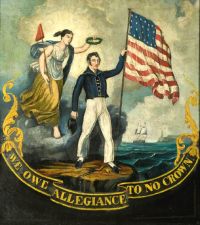The Era of Good Feelings
 With a surge of national pride and political unity, America entered the Era of Good Feelings following the end of the War of 1812. America began to grow economically, and a sense of nationhood was established that manifested itself in the creation of home-based industries, a revision of the banking system, and an expansion of the commercial infrastructure, of which the construction of the Erie Canal was a major project. At the same time, great cities were being extended and rebuilt, and a new monumental architecture, in the Greek revival taste, became a symbol of permanence and optimism for the republic.
With a surge of national pride and political unity, America entered the Era of Good Feelings following the end of the War of 1812. America began to grow economically, and a sense of nationhood was established that manifested itself in the creation of home-based industries, a revision of the banking system, and an expansion of the commercial infrastructure, of which the construction of the Erie Canal was a major project. At the same time, great cities were being extended and rebuilt, and a new monumental architecture, in the Greek revival taste, became a symbol of permanence and optimism for the republic.
Jefferson’s Embargo Acts of 1807 and 1808, together with French and English war-time trade restrictions had effectively blockaded maritime commerce for almost a decade. Stockpiles of British goods were ready for export, and America, with its nascent industrial base, was obliged to import both the necessities and luxuries of life. The potters of Staffordshire were relieved to regain access to their most lucrative market and enthusiastically resumed their trade with America.
 Blue printed pottery had been a staple product since its introduction in the late 18th century. From 1815 the most popular prints were in a bright azure blue, available in a wide variety of patterns from floral and topographical to literary and zoological. By about 1820, a richer darker blue had been introduced, and although it never replaced the “royal” color, it was produced by a small number of manufacturers for about 10 or 15 years. It is apparent from retailers’ order books and archaeological excavations that the darker blue wares enjoyed a brief and intense popularity from about 1820 to 1830. Although made specifically for the American market, most of the patterns continued to be general in nature, but there was a small group of dark blue designs that became perhaps the most desirable of all collectible printed pottery – patterns illustrating the new nation of the United States.
Blue printed pottery had been a staple product since its introduction in the late 18th century. From 1815 the most popular prints were in a bright azure blue, available in a wide variety of patterns from floral and topographical to literary and zoological. By about 1820, a richer darker blue had been introduced, and although it never replaced the “royal” color, it was produced by a small number of manufacturers for about 10 or 15 years. It is apparent from retailers’ order books and archaeological excavations that the darker blue wares enjoyed a brief and intense popularity from about 1820 to 1830. Although made specifically for the American market, most of the patterns continued to be general in nature, but there was a small group of dark blue designs that became perhaps the most desirable of all collectible printed pottery – patterns illustrating the new nation of the United States.
